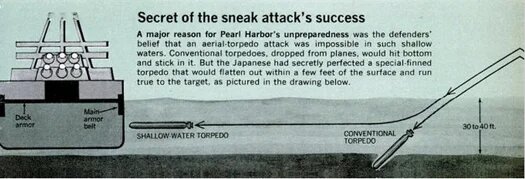The Japanese Ships That Attacked Pearl Harbor and Their Fate
1st Air Fleet Kidō Butai ("Mobile Force"), Admiral C. Nagumo, IJN
CV-Akagi
Set on fire by planes from Enterprise (CV-6), 4 June 1942. Torpedoed and scuttled by destroyers Arashi and Nowaki on 5 June 1942 northwest of Midway Island
CV- Kaga
Set on fire by planes from Enterprise (CV-6) and sunk, 4 June 1942 northwest of Midway Island
CV- Hiryu
Set on fire by planes from Yorktown (CV-5) and Enterprise (CV-6), 4 June 1942 Torpedoed and scuttled by destroyers Kazegumo and Yugumo, 5 June 1942. North West of Midway Island
CV- Soryu
Set on fire and blown up by planes from Yorktown (CV-5). Sunk northwest of Midway Island, 4 June 1942
Nautilus (SS-168) claims to have delivered the death blow by hitting Soryu with two torpedoes shortly after she was hit by Yorktown`s aircraft
CV- Shokaku
Sunk by 3 torpedoes fired from Cavalla (SS-244) 140 miles north of Yap Island, 19 June 1944
CV- Zuikaku
Struck by 6 torpedoes and 7 bombs from aircraft from Essex (CV-9) and Lexington (CV-16) and sunk 220 miles east northeast of Cape Engano, 25 October 1944
BB- Hiei
Crippled by 50 shell hits of 8 inch or less during the first Naval Battle Of Guadalcanal. Struck by 4 torpedoes from aircraft of Enterprise (CV-6) and sunk off Savo Island, 13 November 1942
BB- Kirishima
Disabled by gunfire from Washington (BB-56) during the Second Battle Of Guadalcanal. Kirishima received nine 16 inch and over forty 5 inch hits at a range of only 8400 yards and was scuttled, 15 November 1942
CA- Tone
Sunk in shallow water by aircraft from Task Force 38 near Kure Island, 24 July 1945, broken up for scrap in 1948
CA - Chickuma
Torpedoed by aircraft from Task Force 77.4.2 northeast of Samar. Scuttled by torpedoes from destroyer Nowake October 25 1944
CL- Abukuma
Bombed by U.S.A.A.F. aircraft 10 miles Southeast of Negros, Philippine Islands, 24 October 1944. Sank 26 October 1944
DD- Tanikaze
Torpedoed and sunk by Harder (SS-257) 90 miles South West of Basilan, 9 June 1944
DD- Urakaze
Torpedoed and sunk by Sealion (SS-315) 65 miles north northwest of Keelung, Formosa, 21 November 1944
DD- Isokaze
Damaged by aircraft of Task Force 58. Scuttled 150 miles southwest of Nagasaki, 7 April 1945
DD- Hamakaze
Sunk by aircraft from Hornet (CV-12) and Cabot (CVL-28) 150 miles Southwest of Nagasaki, 7 April 1945
DD- Kasumi
Badly damaged by aircraft from Task Force 58. Scuttled 150 miles Southwest of Nagasaki, 7 April 1945
DD- Arare
Torpedoed and sunk by Growler (SS-215) 7 miles east of Kiska Harbor, Alaska 5 July 1942
DD- Kagero
Damaged by a mine and sunk by US Navy aircraft 5 miles southwest of Rendova, 8 May 1943
DD- Shiranui
Sunk by aircraft of Task Force 77 80 miles north of Panay, 27 October 1944
DD- Akigumo
Torpedoed and sunk by Redfin (SS-272) 30 miles southeast of Zamboanga, 11 April 1944
DD- Akebono
Sailed with Pearl Harbor Task Force but was assigned to bombard Midway Island. Sunk by aircraft from Task Force 38 in Manila Bay, 13 November 1944
DD- Ushio
Sailed with Pearl Harbor Task Force but was assigned to bombard Midway Island. Ushio was the only Japanese ship that took part on the attack on Pearl Harbor not to be sunk during the war. Ushio surrendered badly damaged and was scrapped in 1946
Supply Group No.1, Captain, Masanao, IJN
Kyokuto Maru - Sunk by US Navy aircraft, 21 September 1944
Kenyo Maru - Sunk by Whale (SS-239), 23 March
Kokuyo Maru - Sunk By Bonefish (SS-223), 30 July 1944
Shinkoku Maru - Sunk by US Navy Aircraft at Truk, 17 February 1944
Supply Group No.2, Captain Kazutaka Niimi IJN
Toho Maru - Sunk by Gudgeon (SS-211), 29 March 1943
Nippon Maru (i.e. Nihon Maru) - Sunk by Scamp (SS-277), 14 January 1944
Toei Maru - Sunk By Silversides (SS-236), 18 January 1943.
-----
[media=https://youtu.be/JzFr-uNTXxc]



